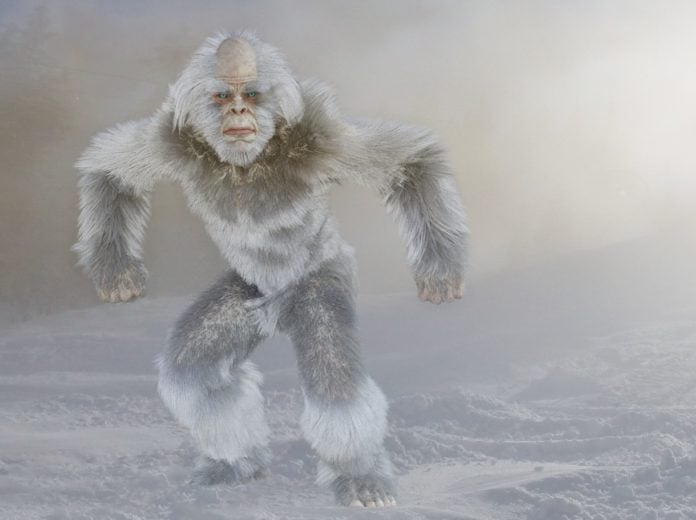I have a confession – I have an irrational fear of yetis.
Do I believe they exist?
No.
Does that keep my brain from being anxious if I think about them too long?
No.
I blame Tintin in Tibet for this. Yes, the yeti took care of Tintin’s friend whose plane crashed, but I still get anxiety at the part where Tintin goes into a cave to see if his friend sheltered there. Even though I’ve seen the story several times and I know there’s no yeti in the cave, WHAT IF THERE IS? So, like a normal person with crippling fears of cryptozoological creatures, I of course am simultaneously fascinated.
Yetis are ape-like creatures that allegedly* inhabit the Himalayan mountains. They are described to stand between two and four meters tall. One group of peoples used to worship a god of the hunt that was a glacier-dwelling creature that resembled a wild man. This being would carry a rock with him as a weapon and it would make a swooshing sound when thrown. Another source I found said that the yeti carries a magic stone in his left armpit, and he throws it at yaks to stun and kill them (probably to eat them.) It isn’t hard to see the connection.
A lot can also be gleaned about what the yeti looks like based on the etymologies of the words used for it in different regions. The word yeti comes form the Tibetan word yachê, a compound word of “ya” and “chê”, meaning rocky/rocky place and bear respectively. Some other terms include: michê (man-bear), migoi or mi-go (wild man), bun manchi (jungle man), and kang admi (snow man). As for the term “abominable snowman”, it was first used in 1921 by the English team documenting Lieutenant-Colonel Charles Howard-Bury’s Mount Everest expedition.
In his book about Himalayan anthropology, H. Siiger asserts that the yeti was a part of pre-Buddhist imaginations, but do you think that I could find any of these stories? Yes. Eventually. It was made more difficult by the fact that most Google searches turn up sites by cryptozoologists showcasing their latest evidence proving the yeti’s existence. But eventually I was successful.
Most stories assert that unless one escaped the yeti, one wouldn’t live to tell the tale. One tale I found recounts the story of an old man who went to grind some corn at an abandoned mill. Arriving too late to make the return journey by daylight, he decided to camp overnight. In the middle of the night he is woken by a yeti, who demands to know why the man is there. He explains himself, but the yeti informs him that the millhouse is his hiding place, and now that the man has seen him, he has to die. The quick-thinking man asks the yeti if he may anoint his legs before death, as is the custom of his people, and the yeti agrees. The man rubs butter on his legs, explaining to the yeti that his people rub their legs with butter so when they die their legs can carry them swiftly wherever they want to go. Intrigued, the yeti demands that the old man put some butter on his own legs. So, the old man anoints the yeti’s legs, but he secretly uses pine resin instead of butter. The man then took a burning firebrand and held it close to his own legs so that the butter melted off. But when he held it to the yeti’s legs, the resin caught fire, setting the yeti ablaze. The yeti shrieked and fled, never to be seen again.
So that was some of the scant information I was able to dig up on yetis. To end, I’ll share a proverb I found during my search: “There is a yeti in the back of everyone’s mind; but the blessed are not haunted by it.” – Old Sherpa Wisdom
*I say allegedly because there are some people who believe they exist. And the yeti was actually designated a protected species in Nepal in 1958, so go figure.









